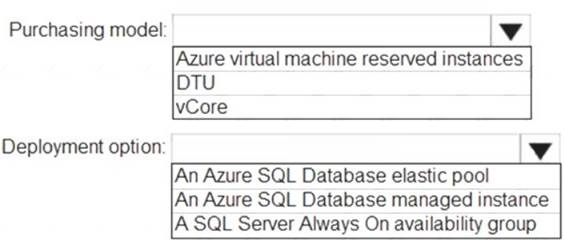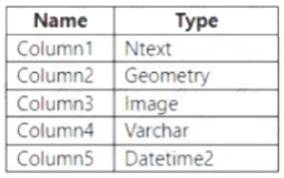- (Exam Topic 1)
You need to implement authentication for ResearchDB1. The solution must meet the security and compliance requirements.
What should you run as part of the implementation?
Correct Answer:
E
Scenario: Authenticate database users by using Active Directory credentials.
(Create a new Azure SQL database named ResearchDB1 on a logical server named ResearchSrv01.) Authenticate the user in SQL Database or SQL Data Warehouse based on an Azure Active Directory user: CREATE USER [Fritz@contoso.com] FROM EXTERNAL PROVIDER;
Reference:
https://docs.microsoft.com/en-us/sql/t-sql/statements/create-user-transact-sql
- (Exam Topic 5)
You need to migrate an on-premises Microsoft SQL Server database to Azure SQL Database. The solution must minimize downtime.
What should you do?
Correct Answer:
C
Reference:
https://docs.microsoft.com/en-us/azure/azure-sql/database/migrate-to-database-from-sql-server#method-1-migra
- (Exam Topic 5)
Note: This question is part of a series of questions that present the same scenario. Each question in the series contains a unique solution that might meet the stated goals. Some question sets might have more than one correct solution, while others might not have a correct solution.
After you answer a question in this section, you will NOT be able to return to it. As a result, these questions will not appear in the review screen.
You have an Azure Data Lake Storage account that contains a staging zone.
You need to design a daily process to ingest incremental data from the staging zone, transform the data by executing an R script, and then insert the transformed data into a data warehouse in Azure Synapse Analytics.
Solution: You schedule an Azure Databricks job that executes an R notebook, and then inserts the data into the data warehouse.
Does this meet the goal?
Correct Answer:
B
Must use an Azure Data Factory, not an Azure Databricks job. Reference:
https://docs.microsoft.com/en-US/azure/data-factory/transform-data
- (Exam Topic 1)
You need to recommend the appropriate purchasing model and deployment option for the 30 new databases. The solution must meet the technical requirements and the business requirements.
What should you recommend? To answer, select the appropriate options in the answer area.
NOTE:Each correct selection is worth one point.
Solution:
Box 1: DTU
Scenario: The 30 new databases must scale automatically.
The 30 new databases must scale automatically. Once all requirements are met, minimize costs whenever possible.
Once all requirements are met, minimize costs whenever possible.
You can configure resources for the pool based either on the DTU-based purchasing model or the vCore-based purchasing model.
In short, for simplicity, the DTU model has an advantage. Plus, if you’re just getting started with Azure SQL Database, the DTU model offers more options at the lower end of performance, so you can get started at a lower price point than with vCore.
Box 2: An Azure SQL database elastic pool
Azure SQL Database elastic pools are a simple, cost-effective solution for managing and scaling multiple databases that have varying and unpredictable usage demands. The databases in an elastic pool are on a single server and share a set number of resources at a set price. Elastic pools in Azure SQL Database enable SaaS developers to optimize the price performance for a group of databases within a prescribed budget while delivering performance elasticity for each database.
Reference:
https://docs.microsoft.com/en-us/azure/azure-sql/database/elastic-pool-overview https://docs.microsoft.com/en-us/azure/azure-sql/database/reserved-capacity-overview
Does this meet the goal?
Correct Answer:
A
- (Exam Topic 5)
You have an Azure SQL database named DB1. DB1 has a table named Table1 that contains the following columns.
You plan to enable Always Encrypted for Table1.
Which two columns support encryption? Each correct answer presents a complete solution. NOTE: Each correct selection is worth one point
Correct Answer:
AD